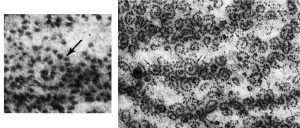3.07: Protein Synthesis IV: Translation
- Page ID
- 96228
21
Protein Synthesis IV: Translation
Andrea Bierema
Learning Objectives
Students will be able to:
- Explain how mRNA is translated to synthesize protein.
- Describe the role of the ribosome, the tRNAs, and the mRNA in translation.
- Identify at which point on the mRNA molecule translation begins.
- Explain what happens when a stop codon on the mRNA is reached during translation.
Overview
So far in this book, we have learned how RNA is made, processed, and regulated. This chapter focuses on how translation works; that is, how information coded in the mRNA molecule is read to create an amino acid sequence (i.e., polypeptide), which then folds into a protein. Please see an earlier chapter for a general overview of translation and which codons (i.e., base sequences) code for which amino acids.

The Process of Translation: A First Look
Let’s first look at a basic overview of what the process of translation looks like. The video below begins with the mRNA leaving the nucleus and binding with a ribosome. TransferRNAs (tRNAs) move in and out of the ribosome, carrying an amino acid into the ribosome and then leaving without it. An amino acid sequence (i.e., a polypeptide) is produced.
An interactive H5P element has been excluded from this version of the text. You can view it online here:
https://openbooks.lib.msu.edu/isb202/?p=132#h5p-119
For closed captioning or to view the full transcript, click on the “YouTube” link in the video (or click here) and view the video on YouTube.
Exercise
Now that you have watched a basic overview of translation, test your knowledge with the following activity in which you place the following translation steps in the correct order.
An interactive H5P element has been excluded from this version of the text. You can view it online here:
https://openbooks.lib.msu.edu/isb202/?p=132#h5p-120
Molecules
The following video lists the different molecules at play in translation. While watching it, consider how each of these molecules played a role in the first video of this chapter. Watch this before moving on to the mechanism.
An interactive H5P element has been excluded from this version of the text. You can view it online here:
https://openbooks.lib.msu.edu/isb202/?p=132#h5p-121
Mechanism
The first video in this chapter quickly showed what translation looks like. The following video slows down the process and explains in more detail what is happening in the ribosome.
An interactive H5P element has been excluded from this version of the text. You can view it online here:
https://openbooks.lib.msu.edu/isb202/?p=132#h5p-122
The Process of Translation: A Detailed Look
This chapter began with an overview of translation and then described in more detail what is happing in the ribosome and how the amino acid chain builds. Now watch the following video, which is an in-depth version of the first video of this chapter, now incorporating aspects described throughout this chapter.
An interactive H5P element has been excluded from this version of the text. You can view it online here:
https://openbooks.lib.msu.edu/isb202/?p=132#h5p-123
For closed captioning or to view the full transcript, click on the “YouTube” link in the video (or click here) and view the video on YouTube.
The animations above focused on what happens at a single ribosome. In reality, though, an mRNA molecule may have several ribosomes attached to it at once, making multiple copies of the protein. They all begin at the first codon, but as one starts moving down the mRNA, another can attach; therefore, they all make the same protein.


